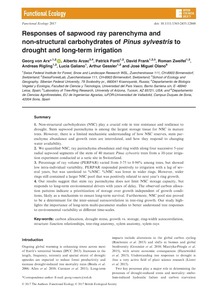Responses of sapwood ray parenchyma and non-structural carbohydrates of Pinus sylvestris to drought and long-term irrigation
Скачать файл:
URI (для ссылок/цитирований):
http://onlinelibrary.wiley.com/doi/10.1111/1365-2435.12860/abstracthttps://elib.sfu-kras.ru/handle/2311/69694
Автор:
Georg, Von Arx
Alberto, Arzac
Patrick, Fonti
David, Frank
Roman, Zweifel
Andreas, Rigling
Lucia, Galiano
Arthur, Gessler
Jose, Miguel Olano
Коллективный автор:
Институт экологии и географии
Laboratory of Biogeochemestry of Ecosystems
Дата:
2017-07Журнал:
Functional EcologyКвартиль журнала в Scopus:
Q1Квартиль журнала в Web of Science:
Q1Библиографическое описание:
Georg, Von Arx. Responses of sapwood ray parenchyma and non-structural carbohydrates of Pinus sylvestris to drought and long-term irrigation [Текст] / Von Arx Georg, Arzac Alberto, Fonti Patrick, Frank David, Zweifel Roman, Rigling Andreas, Galiano Lucia, Gessler Arthur, Miguel Olano Jose // Functional Ecology. — 2017. — Т. 31 (№ 7). — С. 1371-1382Текст статьи не публикуется в открытом доступе в соответствии с политикой журнала.
Аннотация:
1. Non-structural carbohydrates (NSC) play a crucial role in tree resistance and resilience to
drought. Stem sapwood parenchyma is among the largest storage tissue for NSC in mature
trees. However, there is a limited mechanistic understanding of how NSC reserves, stem parenchyma
abundance and growth rates are interrelated, and how they respond to changing
water availability.
2. We quantified NSC, ray parenchyma abundance and ring width along four successive 5-year
radial sapwood segments of the stem of 40 mature Pinus sylvestris trees from a 10-year irrigation
experiment conducted at a xeric site in Switzerland.
3. Percentage of ray volume (PERPAR) varied from 3 75 to 8 94% among trees, but showed
low intra-individual variability. PERPAR responded positively to irrigation with a lag of several
years, but was unrelated to %NSC. %NSC was lower in wider rings. However, wider
rings still contained a larger NSC pool that was positively related to next year’s ring growth.
4. Our results suggest that stem ray parenchyma does not limit NSC storage capacity, but
responds to long-term environmental drivers with years of delay. The observed carbon allocation
patterns indicate a prioritization of storage over growth independent of growth conditions,
likely as a mechanism to ensure long-term survival. Furthermore, NSC pool size proved
to be a determinant for the inter-annual autocorrelation in tree-ring growth. Our study highlights
the importance of long-term multi-parameter studies to better understand tree responses
to environmental variability at different time-scales.

